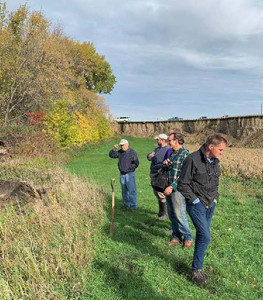Soil Surveys
- mrfimpacts
- 4 days ago
- 3 min read

Soil is the foundation of agriculture and many other ecosystem services. Information about soil type, properties, and functions is essential for agriculture and natural resource management, land appraisals, urban planning, and more.
Soil scientists are working to make soil survey information more robust and reliable.
Pedologists at land-grant universities in the North Central U.S. are working together to:
Identify and prioritize needs for soil-landscape research and education
Refine systems for collecting soil data and assessing soil health
Improve scientific understanding of soil, water, and geomorphic processes at various scales
A multistate, multidisciplinary approach is critical.
Sharing knowledge and tools to conduct efficient research is increasingly important as the number of soil scientists and supporting resources continues to decline. Bringing together pedologists from each State Agricultural Experiment Station in the North Central region allows a better understanding of how soil properties and soil-landscape dynamics change at different scales and vary across states. This means scientists can give user groups (farmers, land managers, restoration ecologists, etc.) better information for their localities.
Project Highlights
This project is an essential partner in the National Cooperative Soil Survey, helping investigate, inventory, classify, interpret, and share information about soils in the North Central region.
Project members design, review, and test procedures and practices for collecting soil survey information. Their scientific and technical expertise has improved systems for storage, retrieval, analysis, and display/dissemination of soil survey information.
Updates to soil taxonomy have contributed to the national soil classification system and international efforts to standardize and improve soil classification.
Serving on USDA Natural Resource Conservation Service advisory boards and committees, project members review policies and recommend improved procedures for the soil survey program. In particular, project members are working with USDA NRCS to:
Develop digital soil visualization and mapping techniques (Purdue University, University of Minnesota, Iowa State University, Ohio State University)
Improve urban soil mapping (University of Illinois)
Monitor and benchmark soil carbon and soil moisture (Kansas State University, University of Nebraska-Lincoln, University of Minnesota)
Develop Ecological Site Descriptions, contributing to a consistent framework for classifying and describing rangeland and forestland soils (Kansas State University)
Update soil surveys for areas affected by flooding, providing valuable guidance to remediation efforts
Project members produced soil maps for the Soil Explorer platforms for the entire U.S., including territories. In 2022, the website had 8,100 users and 13,000 sessions, and the app was downloaded by more than 1,700 users.
Workshops, trainings, and educational courses have increased awareness of how to conduct soil surveys and use the information, and K-12 and college activities have helped foster the next generation of soil scientists.
Project members produced numerous peer-reviewed publications, contributing to the scientific understanding of soil-landscape function and advancing the field of pedology. Project members also co-edited a Special Issue of Natural Sciences Education documenting innovative approaches to soil science course instruction.
Project Funding & Participation
NCERA3: Soil and Landscape Assessment, Function and Interpretation (2019-2024) is supported in part by USDA NIFA through Hatch Multistate Research Fund allocations to State Agricultural Experiment Stations at participating land-grant universities, including: University of Illinois, Iowa State University, Kansas State University, Michigan State University, University of Minnesota, University of Missouri, University of Nebraska, North Dakota State University, Ohio State University, Oregon State University, Purdue University, South Dakota State University. Learn more: https://nimss.org/projects/18578
This Impact Statement was produced in 2025 by the Multistate Research Fund Impacts Program, which is supported by agInnovation, the State Agricultural Experiment Stations, and the Hatch Multistate Research Fund provided by USDA NIFA. Learn more: mrfimpacts.org





Kommentare